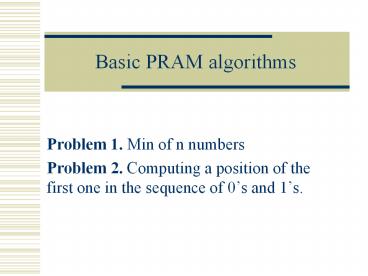Basic PRAM algorithms - PowerPoint PPT Presentation
Title:
Basic PRAM algorithms
Description:
The Common CRCW rule allows concurrent ... minima in the blocks. Complexity. We can compute minimum of n numbers using CRCW PRAM model in O(log log n) with n ... – PowerPoint PPT presentation
Number of Views:133
Avg rating:3.0/5.0
Title: Basic PRAM algorithms
1
Basic PRAM algorithms
- Problem 1. Min of n numbers
- Problem 2. Computing a position of the first one
in the sequence of 0s and 1s.
2
Basic techniques for CRCW PRAM
- The Common CRCW rule allows concurrent writes
only when all the processors attempting to write
into a common memory location are trying to write
the same value. - Problem 1. Min of n numbers
- Sequential solution linear time
- Parallel optimal solution constant time and
linear - number of processors.
3
The following program computes MIN of n numbers
stored in the array C1..n in O(1) time with n2
processors.
- Algorithm A1
- for each 1? i ? n do in parallel
- Mi0
- for each 1? i,j ? n do in parallel
- if i?j Ci ? Cj then Mj1
- for each 1? i ? n do in parallel
- if Mi0 then outputi
4
Let us reduce a number of processors
- Assume that we have an algorithm Ak working in
O(1) time with processors - Algorithm Ak1
- 1.Let ?1/2
- 2. Partition the input array C of size n into
disjoint - blocks of size n? each
- 3. Apply in parallel algorithm Ak to each of
these blocks - 4. Apply algorithm Ak to the array C
consisting of n/ n? - minima in the blocks.
5
Complexity
- We can compute minimum of n numbers using CRCW
PRAM model in O(log log n) with n processors by
applying a strategy of partitioning the input
into pieces of size - ParCost n ? log log n
6
Problem 2. Computing a position of the first one
in the sequence of 0s and 1s.
- FIRST-ONE-POSITION(A)4 for the input array
- A0,0,0,1,0,0,0,1,1,1,0,0,0,1
- Algorithm A (2 parallel steps and n2 processors)
- for each 1? iltj ? n do in parallel
- if Ai 1 and Aj1 then Aj0
- for each 1? i ? n do in parallel
- if Ai 1 then FIRST-ONE-POSITIONi
7
Reducing number of processors
- Algorithm B
- it reports if there is any one in the table.
- There-is-one0
- for each 1? i ? n do in parallel
- if Ai 1 then There-is-one1
8
Now we can merge two algorithms
- Partition table A into segments of size
- In each segment apply the algorithm B
- Find position of the first one in these sequence
by applying algorithm B - Apply algorithm A to this single segment and
compute the final value
9
Complexity
- We apply twice algorithm A each time to the array
of length - which need only ( )2 n
processors - The time is O(1) and number of processors is n.































